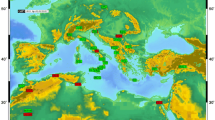Abstract
Receiver functions of teleseismic waveforms recorded at four Hungarian permanent broadband stations have been analyzed using semilinearized and stochastic inversion methods to estimate the crustal thickness and S wave velocity structure in the Pannonian Basin. The results of both inversion methods agree well with the crustal thicknesses obtained by previous seismic refraction and reflection studies in the regions which are densely covered with seismic lines (28 and 27 km in westernmost and southern Hungary, respectively) and suggest a thicker crust compared to what was known before beneath the Transdanubian and Northern Ranges (34 and 33 km, respectively). The comparison of the one-dimensional shear wave velocity models derived by the different inversion methods shows that, in case of simple, smoothly varying structures, the results do not differ significantly and can be regarded as absolute velocities. Otherwise, the recovered velocity gradients agree, but there are differences in the absolute velocity values. The back-azimuthal variations of both radial and tangential receiver functions are interpreted as dipping structure and as waves sampling different geological areas. The signature of the deep structure on low-frequency receiver functions suggests a strong velocity contrast at the 670-km discontinuity. The vanishing 410-km boundary may be attributed to the remnant of a subducted oceanic slab with increased Poisson’s ratio in the transition zone.
Similar content being viewed by others
References
Ádám A, Landy K, Nagy Z (1989) New evidence for the distribution of the electric conductivity in the Earth’s crust and upper mantle in the Pannonian Basin as a “hotspot”. Tectonophysics 164:361–368
Ammon CJ, Randall GE, Zandt G (1990) On the nonuniqueness of receiver function inversions. J Geophys Res 95:15303–15318
Bada G, Horváth F, Cloething S, Coblentz D, Tóth T (2001) Role of topography-induced gravitational stresses in basin inversion: the case study of the Pannonian Basin. Tectonics 20(3):343–363
Birch F (1961) The velocity of compressional waves in rocks to 10 kilobars, part 2. J Geophys Res 66:2199–2224
Bus Z (2003) S-wave velocity structure beneath the Mátra Mountains (Hungary) inferred from teleseismic receiver functions. Acta Geod Geophys Hung 38(1):93–102
Cammarano F, Goes S, Vacher P, Giardini D (2003) Inferring upper-mantle temperatures from seismic velocities. Phys Earth Planet Inter 138(3):197–222
Grad M, Guterch A, Keller GR, Janik T, Hegedűs E, Vozár J, Ślączka A, Tiira T, Yliniemi J (2006) Lithospheric structure beneath trans-Carpathian transect from Precambrian platform to Pannonian Basin: CELEBRATION 2000 seismic profile CEL05. J Geophys Res 111:B03301
Hetényi G, Cattin R, Vergne J, Nábĕlek JL (2006) The effective elastic thickness of the India Plate from receiver function imaging, gravity anomalies and thermomechanical modelling. Geophys J Int 167(3):1106–1118
Heuer B, Kämpf H, Kind R, Geissler WH (2007) Seismic evidence for whole lithosphere separation between Saxothuringian and Moldanubian tectonic units in central Europe. Geophys Res Lett 34:L09304
Horváth F (1993) Towards a mechanical model for the formation of the Pannonian Basin. Tectonophysics 226:333–357
Horváth F, Bada G, Windhoffer G, Csontos L, Dövényi P, Fodor L, Grenerczy G, Síkhegyi F, Szafián P, Székely B, Timár G, Tóth L, Tóth T (2005) Atlas of the present-day geodynamics of the Pannonian Basin: Euroconform maps with explanatory text. http://geophysics.elte.hu/projektek/geodinamikai_atlasz_eng.htm
Hrubcová P, Środa P, Špičák A, Guterch A, Grad M, Keller GR, Brueckl E, Thybo H (2005) Crustal and uppermost mantle structure of the Bohemian Massif based on CELEBRATION 2000 data. J Geophys Res 110:B11305
Karátson D, Csontos L, Harangi Sz, Székely B, Kovácsvölgyi S (2001) Volcanic successions and the role of destructional events in the Western Mátra Mountains, Hungary: implications for the volcanic structure. Géomorphologie 2:79–92
Kennett BLN, Engdahl ER (1991) Traveltimes for global earthquake location and phase identification. Geophys J Int 105:429–465
Langston C (1979) Structure under Mount Rainier, Washington, inferred from teleseismic body waves. J Geophys Res 84:4749–4762
Ligorría J, Ammon CJ (1999) Iterative deconvolution and receiver-function estimation. Bull Seismol Soc Am 88:1395–1400
Ligorría JP (2000) An investigation of the mantle–crust transition beneath North-America and Poisson’s ratio of the North American Crust. Ph.D. thesis, Saint Louis University – St. Louis, MO, USA
Mónus P (1995) Travel time curves and crustal velocity model for the Pannonian basin. Technical Report, MTA GGKI, Budapest, 6 pp
Praus O, Pěčová J, Petr V, Babuška V, Plomerová J (1990) Magnetotelluric and seismological determination of the lithosphere-asthenosphere transition in Central Europe. Phys Earth Planet Inter 60:212–228
Sambridge M (1999) Geophysical inversion with a neighbourhood algorithm – I. Searching the parameter space. Geophys J Int 138:479–494
Sambridge M (2001) Finding acceptable models in nonlinear inverse problems using a neighbourhood algorithm. Inverse Problems 17:387–403
Savage MK (1998) Lower crustal anisotropy or dipping boundaries? Effects on receiver functions and a case study in New Zealand. J Geophys Res 103:15069–15087
Środa P, Czuba W, Grad M, Guterch A, Tokarski AK, Janik T, Rauch M, Keller GR, Hegedüs E, Vozár J, CELEBRATION 2000 Working Group (2006) Crustal and upper mantle structure of the Western Carpathians from CELEBRATION 2000 profiles CEL01 and CEL04: seismic models and geological implications. Geophys J Int 167(2):737–760
Świeczak M, Grad M, TOR and SVEKALAPKO working groups (2004) Upper mantle seismic discontinuities topography variations beneath Eastern Europe. Acta Geophys Pol 52(3):251–270
Tapponnier P (1976) Évolution tectonique du système alpin en Méditerranée: poinçonnement et écrasement rigide-plastique. Bull Soc Géol France XIX(3):437–460
Wessel P, Smith WHF (1991) Free software helps map and display data. EoS Trans. AGU, 72, pp. 441 and 445–446
Wilde-Piórko M, Saul J, Grad M (2005) Differences in the crustal and uppermost mantle structure of the Bohemian Massif from teleseismic receiver functions. Stud Geophys Geod 49(1):85–107
Wortel MJT, Spakman W (2000) Subduction and slab detachment in the Mediterranean–Carpathian region. Science 290:1910–1917
Zhu L, Kanamori H (2000) Moho depth variation in southern California from teleseismic receiver functions. J Geophys Res 105:2969–2980
Author information
Authors and Affiliations
Corresponding author
Rights and permissions
About this article
Cite this article
Hetényi, G., Bus, Z. Shear wave velocity and crustal thickness in the Pannonian Basin from receiver function inversions at four permanent stations in Hungary. J Seismol 11, 405–414 (2007). https://doi.org/10.1007/s10950-007-9060-4
Received:
Accepted:
Published:
Issue Date:
DOI: https://doi.org/10.1007/s10950-007-9060-4




